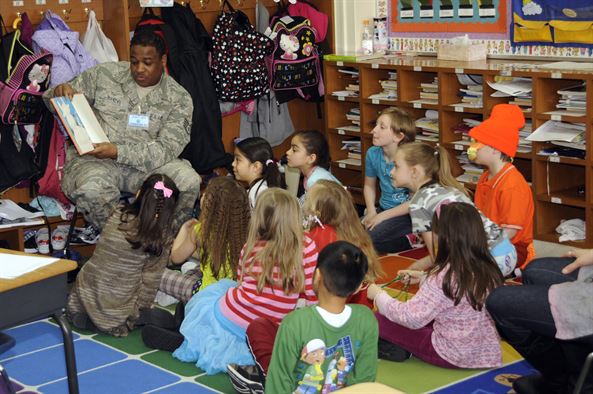![https://commons.wikimedia.org/wiki/File%3AUS_Navy_050114-N-3659B-050_he_Morale_Welfare_and_Recreation_Child_Development_Center_on_board_Naval_Support_Activity_Mid-South_in_Millington%2C_Tenn.%2C_provides_daycare_services.jpg; By U.S. Navy photo by Photographer’s Mate 3rd Class Joseph M. Buliavac [Public domain], via Wikimedia Commons](https://wp-media.patheos.com/blogs/sites/533/2016/05/1024px-thumbnail-1024x667.jpg)
“Medicare for all” has been the Progressives’ rallying cry for a while now, and Bernie Sanders has gotten 16 co-sponsors on his latest bill, which he himself admits is just an effort to “begin the debate” and which even Slate criticizes for its lack of any funding sources.
Now, in that same “for all” spirit, Progressives are promoting a bill being touted as “Child Care for All,” and which came accross my twitter feed as #ChildCare4All. Sponsored by Senator Patty Murray, this is a breathtakingly expansive proposal. Here’s the summary of the legislation, which doesn’t really do it justice, and a fact sheet which doesn’t provide many facts; you really have to read the full text — or just sit tight while I do the same.
And, to caveat this properly, this bill, like pretty much everything else, has all manner of amendments to other legislation, which means, on top of a skim of its 95 pages, that I may end up misstating some component or another. But here goes:
Appropriations:
$20 billion in 2018
$30 billion in 2019
$40 billion in 2020
“such sums as may be necessary for fiscal year 2021 and each subsequent fiscal year”
Does this mean that this bill serves as a blank check? That spending is unlimited in the same way as, say, food stamps’ spending depends only on how many sign up, not on a specific appropriation (so far as I understand)?
“Tiered” classification system:
Each state will develop a system for measuring child care providers, both centers and family-based care, and slotting them into “tiers” based on their quality. The standards applied to the “entry tier” are intended to “increase in rigor over time.”
Copayments: any participating childcare provider receiving funds in this program may not charge eligible families more than the designated copayment.
Children with disabilities: providers are required to prioritize children/infants/toddlers with disabilities with available slots; at the same time, early intervention service providers will provide appropriate services.
Payment rates: each state will develop a set of payment rates based on a HHS-approved cost-estimation model, with different rates for each quality tier, and optionally with a bonus for providers with nontraditional service hours. The cost-estimation model will reflect variations in cost by geographic area, type of provider, age of child, additional expenses associated with providing disability-inclusive care. The payment rates will be set to ensure that providers at each tier “receive payment that is not less than the cost of meeting the requirements of such tier,” and that workers are paid wages “comparable to wages for elementary educators with similar credentials and experience in the State” and “provide a living wage.” (Side note: “living wage” is not defined in the text.)
Parents’ copayment:
For family income less than 75% of the state’s median income, no payment is required.
For 75% – 100% of median income, the copayment increases to 2% of family income (total, regardless of the number of children).
For 100% – 125%, up to 4% of income.
At 150% of income, 7% of that income. And above 150%, the subsidy vanishes.
Note that “family income” is never defined. And, to avoid confusion, this is not the usual 150% of poverty line, this is 150% of median income, which is, across the country, about $60,000 at the moment.
Various sums of money are also allotted for the purpose of constructing or renovating facilities to be used for childcare, with priority given to daycare centers providing inclusive care for the disabled, care during nontraditional hours, rural providers, and poor areas, or to provide grants to improve quality, for instance, by moving informal care providers into the formal tiered system of care, or to move lower-tier providers into upper tiers. States can also use grant money to establish or support resource and referral agencies. can fund training for child care workers (including in-service type training as well as scholarships for credentials and apprenticeship programs).
The FMAP:
That’s the key, apparently. FMAP means Federal Matching Assistance Percentages, and these are the percentages — varying between 50% – 83% by state — that the federal government kicks in for such programs as Medicaid, with the state providing the remainder. This is the state’s “skin in the game.” However, these predefined percentages don’t apply for infants or toddlers (under age 3), where the federal government will pay 90% of costs, and “costs incurred by the STate in carrying out sections 658H and 658K” (which appear to be background checks and reporting requirements) are covered at 50%.
Nondiscrimination: no one may be discriminated against, yadda yadda yadda. If the government cash is less than 80% of the operating budget, then the provider may, for slots not “funded directly with assistance provided,” favor families which participate in the “activities” of the organization.
High quality preschool: states will also make grants to “expand access to high-quality preschool programs for all children.” I’m not sure that the difference between “high quality preschool” and “high quality childcare” is, except that the former seems to be more school-like and perhaps it’s presumed that these grants will be focused on programs providing benefits through schools. Is “preschool” intended to be similar to existing preschools used by parents who don’t need full-day care but just want a school-preparing experience? It lists subjects that these preschools should teach — but, of course, this “academic” instruction can be done in learning-by-doing fashion, or as seatwork. There’s also more money handed out to make Head Start a full-day, year-round program.
So what’s the bottom line?
I know there are a lot of progressives who dream of a system similar to that in Sweden, in which everyone works, and everyone has virtually free daycare, as much as they want. But does Murray’s bill even make sense?
On the one hand, the bill promises as much virtually-no-cost daycare as you can possibly imagine; on the other hand, the bill speaks of priorities for available slots. Is the expectation that even the relatively minimal cost the states are required to shoulder, is enough to limit state spending, and motivate them to be tightwads, in the same manner as Medicaid does? Or will there, in fact, be limits on the amount of money allocated?
Would available slots be doled out on a per-family basis? Would there be slots allocated per provider, to dole out themselves, with some kind of waiting list? Would states economize by providing slots for the lower-tier/cheaper providers, or would families be able to elect any provider they choose — in which case, if your copay is fixed, you’d pick the highest-ranked provider that’s nearby.
And if you do the math, the top-earning eligible families would pay 7% x $90,000 = $6,300 per year, or $121 per week, regardless of how many kids you have. Earn $90,001 and — well, it’s a moot point because you wouldn’t. Families would do the math very carefully to stay below this income level because the loss of the subsidy would be far too costly.
In fact, this provision of very generous childcare benefits for middle-income earners (or some lucky, slot-obtaining portion of them), benefits contingent on the provider paying their workers at public schoolteacher payscales, would have very distorting effects on the market of providers, in general, as full-cost-payers would see their expenses rise substantially, if the providers are fulfilling the wage and other requirements needed to accept voucher families. Unless, that is, there were, in the end, too few voucher families in a given location to distort the market — but in that case, those families would presumably be unable to find providers, because the cost of accepting voucher families, in the pay increases it would require, would be too much.
Oh, and besides which: for the poor, there is consensus that childcare vouchers to make it possible for single mothers to work, is something the government should be providing. But for the middle class, this program of incredible generosity for some, lack of available places for others, makes no sense. Most people would rather have a moderate subsidy than a chance of winning the lottery, or none at all — and for families to hear a message of generosity and then find out it’s not actually in the cards, will not be received favorably.
And yet — the bill appropriates “such sums as may be necessary” with no true reckoning of its cost, let alone any proposal to fund the program. And the “fact sheet” omits this “fact” as well.
So I don’t quite know what to make of it. Clearly, like Sander’s Medicare bill, this is a bill written by people who want to make a statement rather than think this could be an actual law as it stands. But the statement seems to be, “we’ll give some of you ponies.”
Image: https://commons.wikimedia.org/wiki/File%3AUS_Navy_050114-N-3659B-050_he_Morale_Welfare_and_Recreation_Child_Development_Center_on_board_Naval_Support_Activity_Mid-South_in_Millington%2C_Tenn.%2C_provides_daycare_services.jpg; By U.S. Navy photo by Photographer’s Mate 3rd Class Joseph M. Buliavac [Public domain], via Wikimedia Commons

















